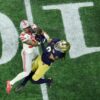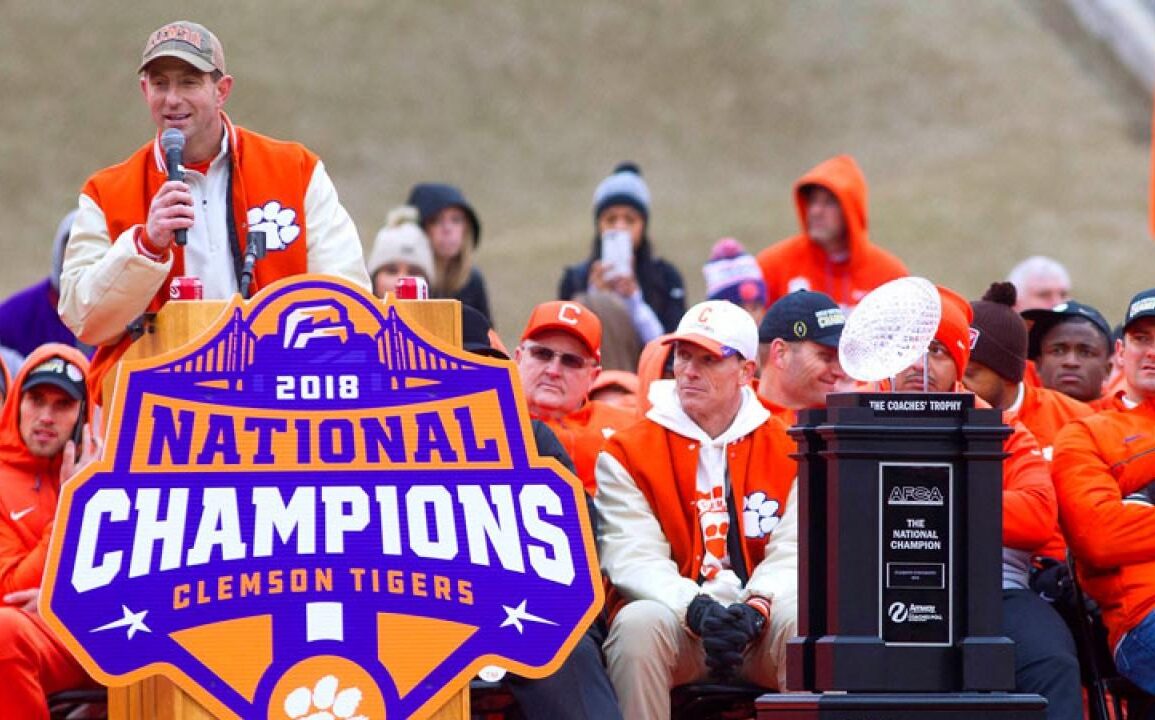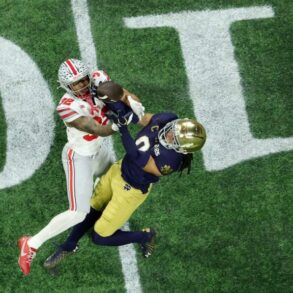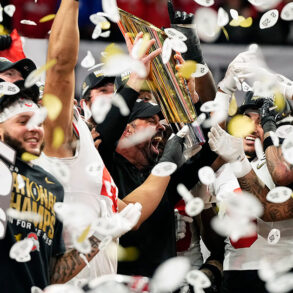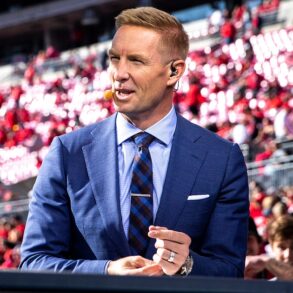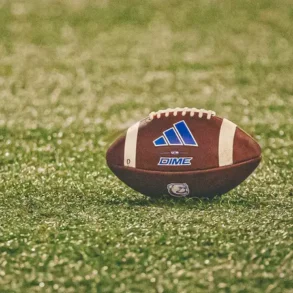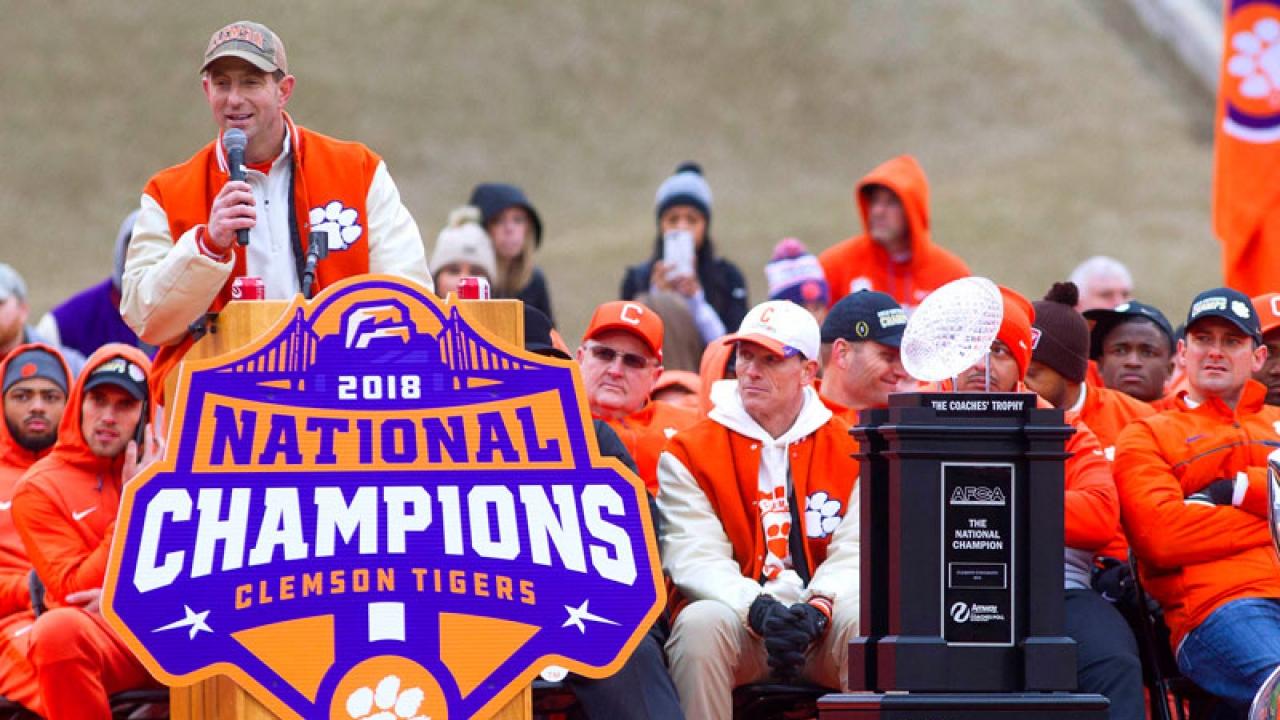
There are many polls to keep track of during the college football season, from the AP Poll and College Football Playoff rankings in the FBS to the FCS and Division II polls. Here’s what you need to know about the major polls — and how college football rankings work.
Some of these polls go back decades. Others, like the College Football Playoff rankings, are much newer.
College football rankings: Every poll explained and how they work
Guide to the College Football Playoff rankings system
Unlike other polls, the College Football Playoff rankings come out only until well into the season. And unlike other polls, it’s the only one that really matters, as it’s for the 12-team playoff. For a decade, the CFP was only a four-team playoff. Starting with the 2024 season, it moved up to 12 teams. The CFP Selection Committee ranks its own top 25, using factors like strength of schedule, results, championships won, common opponents and more.
The 12-team field will be made up of the five conference champions ranked highest by the committee, plus the next seven highest-ranked teams. The four highest-ranked conference champs receive a first-round bye and are seeded one through four. The fifth conference champion ranked the highest will be seeded were it was ranked or at No. 12 if it landed outside the top 12 of the rankings. Any non-conference champion team will be seeded starting at No. 5. Teams seeded 5-12 will play in the first round on campus sites (No. 5 vs. No. 12, No. 6 vs. No. 11, No. 7 vs. No. 10 and No. 8 vs. No. 9). Winners of these games will then play the top four seeds — No. 1 vs. No. 8/9, No. 2 vs. No. 7/10, No. 3 vs. No. 6/11, No. 4 vs. No. 5/12. There will be no re-seeding.
The CFP, which started with the 2014 season, has its committee members meet in person to rank teams.
There is no new CFP rankings after the bowl games or the championship game.
Here is a list of the first No. 1 teams in the College Football Playoff rankings, the final CFP No. 1 team and the eventual national champion for each season of the College Football Playoff rankings:
| Year | First CFP No. 1 | Final CFP No. 1 | National Champion |
|---|---|---|---|
| 2014 | Mississippi State | Alabama | Ohio State |
| 2015 | Clemson | Clemson | Alabama |
| 2016 | Alabama | Alabama | Clemson |
| 2017 | Georgia | Clemson | Alabama |
| 2018 | Alabama | Alabama | Clemson |
| 2019 | Ohio State | LSU | LSU |
| 2020 | Alabama | Alabama | Alabama |
| 2021 | Georgia | Alabama | Georgia |
| 2022 | Tennessee | Georgia | Georgia |
| 2023 | Ohio State | Michigan | Michigan |
| 2024 | Oregon | Oregon | Ohio State |
Here are the College Football Playoff Selection Committee members:
- Chris Ault (former head coach and athletics director at Nevada)
- Chet Gladchuk (athletics director, U.S. Naval Academy)
- Jim Grobe (former head coach, Ohio University, Wake Forest and Baylor)
- Warde Manuel (chair) (athletics director for Michigan)
- Randall McDaniel (College and Pro Football Hall of Fame member and former All-American offensive lineman with Arizona State University)
- Gary Pinkel (former head coach, Toledo and Missouri)
- Mack Rhoades (athletics director for Baylor)
- Mike Riley (former college head coach, Oregon State and Nebraska, as well as head coach in the NFL, CFL, WLAF, AAF and USFL)
- David Sayler (athletics director, Miami (Ohio)
- Will Shields (College and Pro Football Hall of Fame member and former All-American offensive lineman with Nebraska)
- Kelly Whiteside (professor in Sports Media and Journalism, Montclair State; longtime sportswriter, USA Today, Sports Illustrated and Newsday)
- Carla Williams (athletics director for Virginia)
- Hunter Yurachek (Arkansas athletics director)
Guide to the AP Poll Top 25
Starting with the preseason poll, the Associated Press Poll will rank the top 25 teams each week during the season and after the bowl games and the College Football Playoff.
The sportswriters and broadcasters from throughout the country vote individually. Teams are given points on a scale: No. 1 gets you 25, No. 2 gets you 24, etc. These ballots, which are made public each week, are then combined for one AP Top 25 poll.
Once the season starts, the poll is released each Sunday afternoon (except for after Week 1 due to games throughout Labor Day weekend).
The AP Poll voters are not obligated to rank the CFP winner No. 1. In the 2017 season, undefeated UCF, which beat Auburn in the Peach Bowl, received four No. 1 votes. The last time the AP Poll and the Coaches Poll had different No. 1 teams at the end of the season was in 2003, during the BCS era. That year, LSU beat Oklahoma in the Sugar Bowl to win the BCS National Championship and thus the ESPN/Coaches Poll No. 1 ranking. The AP, however, ranked Southern California No. 1 after the Trojans defeated Michigan in the Rose Bowl.
Alabama has the most season-ending No. 1 rankings in AP Poll history with 12. The Crimson Tide finished No. 1 in 1961, 1964, 1965, 1978, 1979, 1992, 2009, 2011, 2012, 2015, 2017 and 2020. Notre Dame is second with eight, winning most recently in 1988.
Minnesota won the first AP title, ranking No. 1 in 1936. The final AP Poll finally came out after the bowl games for good starting with the 1968 season.
Final AP No. 1 teams since the 2000 season:
- 2000: Oklahoma
- 2001: Miami (FL)
- 2002: Ohio State
- 2003: Southern California
- 2004: Southern California
- 2005: Texas
- 2006: Florida
- 2007: LSU
- 2008: Florida
- 2009: Alabama
- 2010: Auburn
- 2011: Alabama
- 2012: Alabama
- 2013: Florida State
- 2014: Ohio State
- 2015: Alabama
- 2016: Clemson
- 2017: Alabama
- 2018: Clemson
- 2019: LSU
- 2020: Alabama
- 2021: Georgia
- 2022: Georgia
- 2023: Michigan
- 2024: Ohio State
All FBS teams can earn rankings in the poll, as can FCS programs. In 2007, Appalachian State upset then-No. 5 Michigan, 34-32, prompting the AP Poll to allow voters to rank FCS teams (“Appalachian State Rule)”. In 2016, North Dakota State upset then-No. 11 Iowa and received 74 votes in the AP Poll.
Guide to the college football Coaches Poll
Like the AP Poll, the Coaches Poll starts with a preseason top 25 and continues weekly on Sundays during the season and after the bowl games. The poll gives teams points on a scale from 1 to 25 (25 for ranking a team No. 1, 24 for No. 2, etc.).
Like the AP Poll, the Coaches Poll isn’t obligated to vote the College Football Playoff winner as the national champion, though it’s been awarded to the same team each year.
The Coaches’ Trophy is awarded to the national champion. Before the CFP, this went to the Bowl Championship Series (BCS) winner. The College Football Playoff has its own trophy.
Through the 1973 season, the final Coaches Poll came out at the end of the regular season but before the bowl games.
College Football: Split national titles
Though the College Football Playoff has eliminated (almost) all worries about avoiding a split national champion, there are instances where there are multiple national champions in a single season. Some of that had to do with different national champions for the AP and Coaches Poll.
Here are the years with split national champions, per this list of champions on NCAA.com, since 1970.
| Year | Schools (Polls) |
|---|---|
| 2003 | LSU (Coaches), Southern California (AP) |
| 1997 | Michigan (AP), Nebraska (Coaches) |
| 1991 | Miami (FL) (AP), Washington (Coaches) |
| 1990 | Colorado (AP), Georgia Tech (Coaches) |
| 1978 | Alabama (AP), Southern California (Coaches) |
| 1974 | Oklahoma (AP), Southern California (Coaches) |
| 1973 | Alabama (Coaches), Notre Dame (AP) |
| 1970 | Nebraska (AP, FWAA), Texas (Coaches, NFF), Ohio State (NFF) |
How the FCS rankings work
Like in FBS, there is more than one poll for the Football Championship Subdivision. The weekly STATS poll is voted on by the media, while the Coaches Poll is voted on by FCS coaches. Both of these polls release a preseason top 25 and continue to vote weekly through the end of the regular season and again after the conclusion of the 24-team playoff.
How the DII football rankings work
Before 1973, champions for the then “NCAA College Division” were decided by polls at the end of the regular season. Starting with 1973, there has been the DII Football Championship.
There are also regional rankings, which play a major role in deciding the playoff participants. The 28-team playoff is made up of seven teams from each of these four regions. Participants in each region are determined by regional rankings. A conference’s highest-ranked team qualifies automatically if it ranks in the top nine. Other participants are determined by the region rankings.
FBS: Championship History
National Champions
| SEASON | CHAMPION | SELECTING ORGANIZATION |
|---|---|---|
| 2024 | Ohio State | CFP |
| 2023 | Michigan | CFP |
| 2022 | Georgia | CFP |
| 2021 | Georgia | CFP |
| 2020 | Alabama | CFP |
| 2019 | LSU | CFP |
| 2018 | Clemson | CFP |
| 2017 | Alabama | CFP |
| 2016 | Clemson | CFP |
| 2015 | Alabama | CFP |
| 2014 | Ohio State | CFP |
| 2013 | Florida State | BCS |
| 2012 | Alabama | BCS |
| 2011 | Alabama | BCS |
| 2010 | Auburn | BCS |
| 2009 | Alabama | BCS |
| 2008 | Florida | BCS |
| 2007 | Louisiana State | BCS |
| 2006 | Florida | BCS |
| 2005 | Texas | BCS |
| 2004 | Southern California* | BCS |
| 2003 | Louisiana State, Southern California | BCS, AP, FWAA |
| 2002 | Ohio State | BCS |
| 2001 | Miami (Fla.) | BCS |
| 2000 | Oklahoma | BCS |
| 1999 | Florida State | BCS |
| 1998 | Tennessee | BCS |
| 1997 | Michigan, Nebraska | AP, FWAA, NFF, USA/ESPN |
| 1996 | Florida | AP, FWAA, NFF,USA/CNN |
| 1995 | Nebraska | AP, FWAA, NFF, USA/CNN, UPI |
| 1994 | Nebraska | AP, FWAA, NFF, USA/CNN, UPI |
| 1993 | Florida St. | AP, FWAA,NFF, USA/CNN, UPI |
| 1992 | Alabama | AP, FWAA, NFF, USA/CNN, UPI |
| 1991 | Washington, Miami (Fla.) | FWAA, NFF, USA/CNN, UPI,AP |
| 1990 | Colorado, Georgia Tech | FWAA, NFF, USA/CNN, AP, UPI |
| 1989 | Miami (Fla.) | AP, FWAA, NFF, USA/CNN, UPI |
| 1988 | Notre Dame | AP, FWAA, NFF, USA/CNN, UPI |
| 1987 | Miami (Fla.) | AP, FWAA, NFF, USA/CNN, UPI |
| 1986 | Penn St. | AP, FWAA, NFF, USA/CNN, UPI |
| 1985 | Oklahoma | AP, FWAA, NFF, USA/CNN, UPI |
| 1984 | Brigham Young | AP, FWAA, NFF, USA/CNN, UPI |
| 1983 | Miami (Fla.) | AP, FWAA, NFF, USA/CNN, UPI |
| 1982 | Penn St. | AP, FWAA, NFF, USA/CNN, UPI |
| 1981 | Clemson | AP, FWAA, NFF, UPI |
| 1980 | Georgia | AP, FWAA, NFF, UPI |
| 1979 | Alabama | AP, FWAA, NFF, UPI |
| 1978 | Alabama, Southern California | AP, FWAA, NFF, UPI |
| 1977 | Notre Dame | AP, FWAA, NFF, UPI |
| 1976 | Pittsburgh | AP, FWAA, NFF, UPI |
| 1975 | Oklahoma | AP, FWAA, NFF, UPI |
| 1974 | Southern California, Oklahoma | FWAA, NFF, UPI, AP |
| 1973 | Notre Dame, Alabama | AP, FWAA, NFF, UPI |
| 1972 | Southern California | AP, FWAA, NFF, UPI |
| 1971 | Nebraska | AP, FWAA, NFF, UPI |
| 1970 | Nebraska, Texas, Ohio St. | AP, FWAA, NFF, UPI, NFF |
| 1969 | Texas | AP, FWAA, NFF, UPI |
| 1968 | Ohio St. | AP, FWAA, NFF, UPI |
| 1967 | Southern California | AP, FWAA, NFF, UPI |
| 1966 | Notre Dame, Michigan St. | AP, FWAA, NFF, UPI, NFF |
| 1965 | Michigan St., Alabama | FWAA, NFF, UPI, AP |
| 1964 | Alabama, Arkansas, Notre Dame | AP, UPI, FWAA, NFF |
| 1963 | Texas | AP, FWAA, NFF, UPI |
| 1962 | Southern California | AP, FWAA, NFF, UPI |
| 1961 | Alabama, Ohio St. | AP, NFF, UPI, FWAA |
| 1960 | Minnesota, Mississippi | AP, NFF, UPI, FWAA |
| 1959 | Syracuse | AP, FWAA, NFF, UPI |
| 1958 | LSU, Iowa | AP, UPI, FWAA |
| 1957 | Ohio St., Auburn | FWAA, UPI, AP |
| 1956 | Oklahoma | AP, FWAA, UPI |
| 1955 | Oklahoma | AP, FWAA, UPI |
| 1954 | UCLA, Ohio St. | FWAA, UPI, AP |
| 1953 | Maryland | AP, UPI |
| 1952 | Michigan St. | AP, UPI |
| 1951 | Tennessee | AP, UPI |
| 1950 | Oklahoma | AP, UPI |
| 1949 | Notre Dame | AP |
| 1948 | Michigan | AP |
| 1947 | Notre Dame | AP |
| 1946 | Notre Dame | AP |
| 1945 | Army | AP |
| 1944 | Army | AP |
| 1943 | Notre Dame | AP |
| 1942 | Ohio St. | AP |
| 1941 | Minnesota | AP |
| 1940 | Minnesota | AP |
| 1939 | Texas A&M | AP |
| 1938 | Texas Christian | AP |
| 1937 | Pittsburgh | AP |
| 1936 | Minnesota | AP |
| 1935 | Minnesota | CFRA, HAF, NCF |
| 1934 | Minnesota | CFRA, HAF, NCF |
| 1933 | Michigan | CFRA, HAF, NCF |
| 1932 | Southern California | CFRA, HAF, NCF |
| 1931 | Southern California | CFRA, HAF, NCF |
| 1930 | Alabama, Notre Dame | CFRA, HAF, NCF |
| 1929 | Notre Dame | CFRA, HAF, NCF |
| 1928 | Georgia Tech. | CFRA, HAF, NCF |
| 1927 | Illinois, Yale | HAF, NCF, CFRA |
| 1926 | Alabama, Stanford | CFRA, HAF, NCF, HAF |
| 1925 | Alabama | CFRA, HAF, NCF |
| 1924 | Notre Dame | CFRA, HAF, NCF |
| 1923 | Illinois, Michigan | CFRA, HAF, NCF, NCF |
| 1922 | California, Cornell, Princeton | NCF, HAF, CFRA, NCF |
| 1921 | California, Cornell | CFRA, NCF, HAF |
| 1920 | California | CFRA, HAF, NCF |
| 1919 | Harvard, Illinois, Notre Dame, Texas A&M | CFRA, HAF, NCF, CFRA, NCF, NCF |
| 1918 | Michigan, Pittsburgh | NCF, HAF, NCF |
| 1917 | Georgia Tech. | HAF, NCF |
| 1916 | Pittsburgh | HAF, NCF |
| 1915 | Cornell | HAF, NCF |
| 1914 | Army | HAF, NCF |
| 1913 | Harvard | HAF, NCF |
| 1912 | Harvard, Penn St. | HAF, NCF, NCF |
| 1911 | Penn St., Princeton | NCF, HAF, NCF |
| 1910 | Harvard, Pittsburgh | HAF, NCF, NCF |
| 1909 | Yale | HAF, NCF |
| 1908 | LSU, Pennsylvania | NCF, HAF, NCF |
| 1907 | Yale | HAF, NCF |
| 1906 | Princeton | HAF, NCF |
| 1905 | Chicago | HAF, NCF |
| 1904 | Michigan, Pennsylvania | NCF, HAF, NCF |
| 1903 | Michigan, Princeton | NCF, HAF, NCF |
| 1902 | Michigan | HAF, NCF |
| 1901 | Michigan | HAF, NCF |
| 1900 | Yale | HAF, NCF |
| 1899 | Harvard | HAF, NCF |
| 1898 | Harvard | HAF, NCF |
| 1897 | Pennsylvania | HAF, NCF |
| 1896 | Lafayette, Princeton | NCF, HAF, NCF |
| 1895 | Pennsylvania | HAF, NCF |
| 1894 | Yale | HAF, NCF |
| 1893 | Princeton | HAF, NCF |
| 1892 | Yale | HAF, NCF |
| 1891 | Yale | HAF, NCF |
| 1890 | Harvard | HAF, NCF |
| 1889 | Princeton | HAF, NCF |
| 1888 | Yale | HAF, NCF |
| 1887 | Yale | HAF, NCF |
| 1886 | Yale | HAF, NCF |
| 1885 | Princeton | HAF, NCF |
| 1884 | Yale | HAF, NCF |
| 1883 | Yale | HAF, NCF |
| 1882 | Yale | NCF |
| 1881 | Yale | NCF |
| 1880 | Princeton, Yale | NCF, NCF |
| 1879 | Princeton | NCF |
| 1878 | Princeton | NCF |
| 1877 | Yale | NCF |
| 1876 | Yale | NCF |
| 1875 | Harvard | NCF |
| 1874 | Yale | NCF |
| 1873 | Princeton | NCF |
| 1872 | Princeton | NCF |
| 1871 | None selected | NCF |
| 1870 | Princeton | NCF |
| 1869 | Princeton, Rutgers | NCF |
* Southern California’s participation in the 2004 championship was vacated by the NCAA Committee on Infractions.
FCS: Championship history
| YEAR | CHAMPION | COACH | SCORE | RUNNER-UP | SITE |
|---|---|---|---|---|---|
| 2024 | North Dakota State | Tim Polasek | 35-32 | Montana State | Frisco, Texas |
| 2023 | South Dakota State | Jimmy Rogers | 23-3 | Montana | Frisco, Texas |
| 2022 | South Dakota State | John Stiegelmeier | 45-21 | North Dakota State | Frisco, Texas |
| 2021 | North Dakota State | Matt Entz | 38-10 | Montana State | Frisco, Texas |
| 2020 | Sam Houston | K.C. Keeler | 23-21 | South Dakota State | Frisco, Texas |
| 2019 | North Dakota State | Matt Entz | 28-20 | James Madison | Frisco, Texas |
| 2018 | North Dakota State | Chris Klieman | 38-24 | Eastern Washington | Frisco, Texas |
| 2017 | North Dakota State | Chris Klieman | 17-13 | James Madison | Frisco, Texas |
| 2016 | James Madison | Mike Houston | 28-14 | Youngstown State | Frisco, Texas |
| 2015 | North Dakota State | Chris Klieman | 37-10 | Jacksonville State | Frisco, Texas |
| 2014 | North Dakota State | Chris Klieman | 29-27 | Illinois State | Frisco, Texas |
| 2013 | North Dakota State | Craig Bohl | 35-7 | Towson | Frisco, Texas |
| 2012 | North Dakota State | Craig Bohl | 39-13 | Sam Houston State | Frisco, Texas |
| 2011 | North Dakota State | Craig Bohl | 17-6 | Sam Houston State | Frisco, Texas |
| 2010 | Eastern Washington | Beau Baldwin | 20-19 | Delaware | Frisco, Texas |
| 2009 | Villanova | Andy Talley | 23-21 | Montana | Chattanooga, Tenn. |
| 2008 | Richmond | Mike London | 24-7 | Montana | Chattanooga, Tenn. |
| 2007 | Appalachian State | Jerry Moore | 49-21 | Delaware | Chattanooga, Tenn. |
| 2006 | Appalachian State | Jerry Moore | 28-17 | Massachusetts | Chattanooga, Tenn. |
| 2005 | Appalachian State | Jerry Moore | 21-16 | UNI | Chattanooga, Tenn. |
| 2004 | James Madison | Mickey Matthews | 31-21 | Montana | Chattanooga, Tenn. |
| 2003 | Delaware | K.C. Keeler | 40-0 | Colgate | Chattanooga, Tenn. |
| 2002 | Western Kentucky | Jack Harbaugh | 34-14 | McNeese State | Chattanooga, Tenn. |
| 2001 | Montana | Joe Glenn | 13-6 | Furman | Chattanooga, Tenn. |
| 2000 | Georgia Southern | Paul Johnson | 27-25 | Montana | Chattanooga, Tenn. |
| 1999 | Georgia Southern | Paul Johnson | 59-24 | Youngstown State | Chattanooga, Tenn. |
| 1998 | Massachusetts | Mark Whipple | 55-43 | Georgia Southern | Chattanooga, Tenn. |
| 1997 | Youngstown State | Jim Tressel | 10-9 | McNeese State | Chattanooga, Tenn. |
| 1996 | Marshall | Bob Pruett | 49-29 | Montana | Huntington, W.Va. |
| 1995 | Montana | Don Read | 22-20 | Marshall | Huntington, W.Va. |
| 1994 | Youngstown State | Jim Tressel | 28-14 | Boise State | Huntington, W.Va. |
| 1993 | Youngstown State | Jim Tressel | 17-5 | Marshall | Huntington, W.Va. |
| 1992 | Marshall | Jim Donnan | 31-28 | Youngstown State | Huntington, W.Va. |
| 1991 | Youngstown State | Jim Tressel | 25-17 | Marshall | Statesboro, Ga. |
| 1990 | Georgia Southern | Tim Stowers | 36-13 | Nevada | Statesboro, Ga. |
| 1989 | Georgia Southern | Erk Russell | 37-34 | Stephen F. Austin * | Statesboro, Ga. |
| 1988 | Furman | Jimmy Satterfield | 17-12 | Georgia Southern | Pocatello, Idaho |
| 1987 | Louisiana-Monroe | Pat Collins | 43-42 | Marshall | Pocatello, Idaho |
| 1986 | Georgia Southern | Erk Russell | 48-21 | Arkansas State | Tacoma, Wash. |
| 1985 | Georgia Southern | Erk Russell | 44-42 | Furman | Tacoma, Wash. |
| 1984 | Montana State | Dave Arnold | 19-6 | Louisiana Tech | Charleston, S.C. |
| 1983 | Southern Illinois | Rey Dempsey | 43-7 | Western Carolina | Charleston, S.C. |
| 1982 | Eastern Kentucky | Roy Kidd | 17-14 | Delaware | Wichita Falls, Texas |
| 1981 | Idaho State | Dave Kragthorpe | 34-23 | Eastern Kentucky | Wichita Falls, Texas |
| 1980 | Boise State | Jim Criner | 31-29 | Eastern Kentucky | Sacramento, Calif. |
| 1979 | Eastern Kentucky | Roy Kidd | 30-7 | Lehigh | Orlando, Fla. |
| 1978 | Florida A&M | Ruby Hubbard | 35-28 | Massachusetts | Wichita Falls, Texas |
* — Stephen F. Austin’s participation in 1989 championship was vacated.
This post was originally published on this site be sure to check out more of their content.


